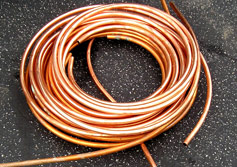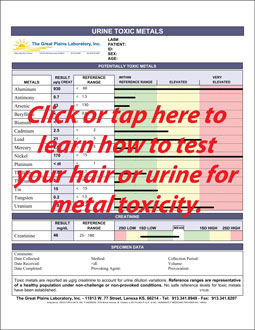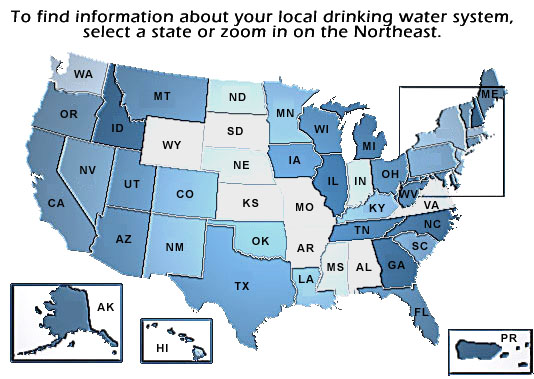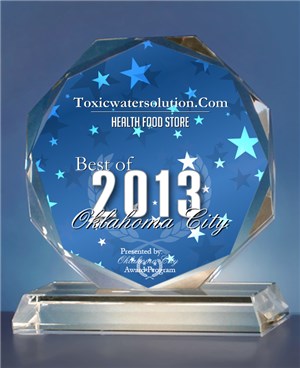
Information, Tests and Solutions to Improve
Your Health and Water Quality |
|||||||||||||||||||||||||||||||||||||||
Copper toxicity is related to heart disease, cancer, kidney damage and memory problems.You can test for copper toxicity in your body with a $16 urine screening test at your own home. Click or tap here to learn more...Or you can send a hair or urine sample to a laboratory for a comprehensive heavy metal toxicity and essential mineral test. Click or tap here to learn more...Copper toxicity in our water and supplements may lead to: [1]
Elevated copper levels also increase the risk of cardiovascular disease. · Levels of copper in the blood were higher among people who died from coronary heart disease than among those who did not. [2] [3] [4] Circulating copper oxidizes LDL cholesterol. [5] [6] [7] Low density lipoprotein (LDL) oxidation is a crucial step in atherosclerosis. [8] · Urine copper levels are higher in men with cardiovascular disease. [9] · Researchers state “It is clear that oxidant damage contributes to many of the diseases of aging, such as atherosclerosis, Alzheimer's disease, Parkinson's diseases, diabetes, diseases of inflammation, diseases of fibrosis, diseases of autoimmunity, and so on. It is equally clear that both iron and copper can contribute to excess production of damaging reactive oxygen species through Fenton chemistry.” [10]
According to the U.S. Environmental Protection Agency (EPA), “approximately one in eight Americans is exposed to potentially harmful microbes, pesticides, lead, or radioactive radon whenever they drink a glass of tap water or take a shower.” [11] . It’s estimated that up to 66% of the toxic metals we have in our body comes from the steam from that relaxing hot shower or bath.
“The primary sources of copper in drinking water are corroding pipes and brass components of household piping systems. Signs that drinking water may have elevated levels of copper include a metallic taste or blue to blue-green stains around sinks and plumbing fixtures. The corrosion leads to the release of copper ions and the deposit of corrosion by-products on the pipe wall. The solubility of these by-products ultimately determines the level of copper at our taps.” [12]
The EPA continues… “Household plumbing materials are the most common source of lead and copper in home drinking water. Corrosive water may cause metals in pipes or soldered joints to leach into your tap water. Your water’s acidity or alkalinity (often measured as pH) greatly affects corrosion. Temperature and mineral content also affect how corrosive it is. They are often used in pipes, solder, or plumbing fixtures. Lead can cause serious damage to the brain, kidneys, nervous system, and red blood cells. The age of plumbing materials — in particular, copper pipes soldered with lead — is also important. Even in low amounts these metals can be harmful” [13]
Your water is corrosive if its pH is less than 7.0. Higher water temperature, typical for bath and showers, dissolves the lead in the pipes and fixtures. The high water temperature dilates the blood vessels in the skin and encourages the absorption of toxins through your skin.
A chemical known as Chloramine (chlorine + ammonia) is popular as a replacement for chlorine in drinking water distribution. Water in copper pipes treated with chloramine release higher amounts of lead than water not treated with chloramine. Higher water temperatures also increase the release of lead. Lead is also common in the solder connections found in residences and business built prior to 1986. Copper concentrations are highest in water that is acidic, pH less than 7.0 [14] [15] Is you water acidic? Find out. Test your water pH.
Another study found water standing in copper tubing for 24 hours had a copper ion concentration of 2.4 mg/L. [16] This copper level is 1.1 mg/L higher than recommended Maximum Contaminant Level (MCL) by the EPA. Metal (copper) ions are what we absorb when we drink, bathe, swim and soak in water. I’ve verified this in my own house!
Even if you have a bath or shower filter, it may not be effective in removing copper. Most shower water filters remove chlorine but may also increase the water copper levels. Most shower filters have copper and zinc in the filter. Your acidic water, pH less than 7.0, will dissolve the copper and zinc and increase the copper water concentrations in your bath and shower. Yes, copper and zinc can be toxic!
Is your shower water filter contributing to a copper toxicity? You can do a toxic metals test and copper check on your body and your shower filter.
The American Journal of Clinical Nutrition states that high levels of copper exposure, through overzealous fortification, supplementation, or drinking water exposure, may be possible. [17] If you have toxic amounts of copper you should not be taking a vitamin supplement with copper! Go get your supplement bottles and look at the labels right now.
You can filter your drinking and bathing water to significantly decrease your copper and lead exposure. You can also remove the toxic metals from your body by doing oral chelation.
Water can be a significant source of copper intake depending upon the geographic
location, water character, water temperature, and the presence of copper pipes. At concentrations above 1 mg/l,
copper can stain laundry and plumbing fixtures. Copper can also cause a greenish/blue tint to blond
hair.
Copper is an essential element at lower levels but above 5 mg/l can cause
gastrointestinal disturbances or other acute toxic effects.
Long term low levels of copper from water and supplements may eventually create
Copper Toxicity. If you are spilling copper into your urine you may be getting too much copper. Order your
Heavy Metal Test via the link in the box below.
How to test your water for Copper Toxicity:How to treat your water for Copper Toxicity: Ugly Shower Filter,Distillation, Reverse Osmosis, or "Soda Ash" Feed[20]
This is not an all-encompassing metal toxicity list. There are other sources of
metal exposure not listed herein.
References:
[1] Medline Plus, U.S. National Library of Medicine and the National Institutes of Health. Accessed September, 2008. [2] Ford ES. Serum copper concentration and coronary heart disease among US adults. Am J Epidemiol 2000;151:1182–8. [3] Age- and dose-dependent effects of an eicosapentaenoic acid-rich oil on cardiovascular risk factors in healthy male subjects. Cazzola R, Russo-Volpe S, Miles EA, Rees D, Banerjee T, Roynette CE, Wells SJ, Goua M, Wahle KW, Calder PC, Cestaro B. Atherosclerosis . 2007 Jul;193(1):159-67. [4] Protective effects of Peganum harmala L. extract, harmine and harmaline against human low-density lipoprotein oxidation. Berrougui H, Isabelle M, Cloutier M, Hmamouchi M, Khalil A., J Pharm Pharmacol. 2006 Jul;58(7):967-74. [5] Effects of capsaicin, dihydrocapsaicin, and curcumin on copper-induced oxidation of human serum lipids. Ahuja KD, Kunde DA, Ball MJ, Geraghty DP. J Agric Food Chem. 2006 Aug 23;54(17):6436-9. [6] Effect of bicarbonate on iron-mediated oxidation of low-density lipoprotein. Arai H, Berlett BS, Chock PB, Stadtman ER., Proc Natl Acad Sci U S A. 2005 Jul 26;102(30):10472-7. [7] Effect of homocysteine, folates, and cobalamin on endothelial cell- and copper-induced LDL oxidation. Ronco AM, Garrido A, Llanos MN, Guerrero-Bosagna C, Tamayo D, Hirsch S., Lipids. 2005 Mar;40(3):259-64. [8] HDL capacity to inhibit LDL oxidation in well-trained triathletes. Brites F, Zago V, Verona J, Muzzio ML, Wikinski R, Schreier L., Life Sci. 2006 May 22;78(26):3074-81. [9] Trace element status in Saudi patients with established atherosclerosis. Alissa EM, Bahjri SM, Ahmed WH, Al-Ama N, Ferns GA., J Trace Elem Med Biol. 2006;20(2):105-14. [10] Exp Biol Med (Maywood). 2007 Feb;232(2):323-35. [11] Jobson MD, Grimm SE 3rd, Banks K, Henley G., The effects of water filtration systems on fluoride: Washington , D.C. metropolitan area. ASDC J Dent Child. 2000 Sep-Oct;67(5):350-4, 302, 304. [12] http://www.epa.gov/nrmrl/wswrd/cr/corr_res_copper.html [13] http://www.epa.gov/safewater/privatewells/health.html accessed07/27/08 [14] Chloramine Decay & Metal Release in Copper Pipes at Varying Temperatures, pH and Chloramine Concentrations. Jeffrey Nicholson, Dr. Marc Edwards, Charles E. Via Jr. Department of Civil & Environmental Engineering, Virginia Polytechnic Institute & State University [15] The Effect of Water Chemistry on the Solubility and Properties of Freshly Precipitated Copper Solids, EPA. [16] Sasahara T, Kikuno R, Nakamura T, Sekiguchi T, Takahashi A, Satoh Y, Takayama Y, Okuda S, Inoue M., [Inactivation of Cryptosporidium parvum oocysts in copper tubing], Kansenshogaku Zasshi. 2006 Jul;80(4):377-82. [17] Cockell KA, Bertinato J, L'Abbé MR., Regulatory frameworks for copper considering chronic exposures of the population. American Journal of Clinical Nutrition. 2008 Sep;88(3):863S-6S. [18] http://www.epa.gov/nrmrl/wswrd/cr/corr_res_copper.html [19] http://dnr.wi.gov/org/water/dwg/copper.htm
| |||||||||||||||||||||||||||||||||||||||
You are here: Home Page > Heavy Metal Toxicity > Copper Toxicity
Natural Care Solution:
Helping People Improve Their Health Naturally Since
1998
|
Quality Water Testing and Analysis for Residential and Commercial Water Sources
My Mission
Provide you with accurate information, economical and
effective tests
and products to evaluate your body and water for toxic metals and remove them if
necessary.
Keith D. Bishop
Clinical Nutritionist
B.Sc. Pharmacy
Health
Coach©

|
*These statements have not been evaluated by the Food and Drug Administration. These products are
not intended to diagnose, treat, cure or prevent any disease.
The information and contents of this website are based upon government, medical,
university and health industry research information.
Consult with your physician or a qualified health care provider before making any changes in your medical or
treatment program.
Please let us know if you have problems viewing anything or ordering on this page:
Thank you for visiting www.ToxicWaterSolution.com! If you find this information helpful or
interesting please send a link to your family and friends.
Copyright © 2007-2016 Natural Care Solution, LLC Keith D. Bishop, Clinical Nutritionist, B.Sc. Pharmacy









